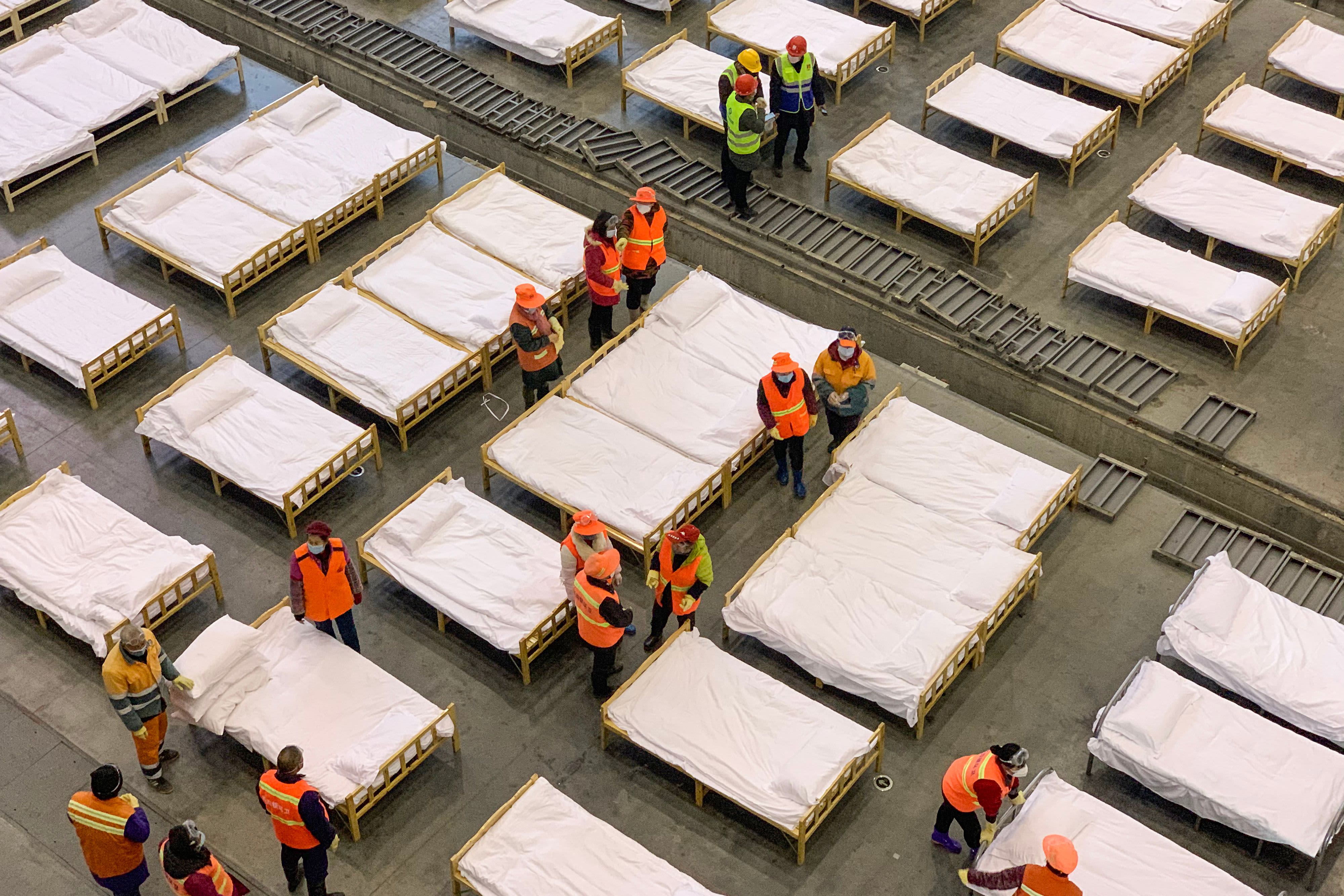
Workers set up beds at an exhibition center that was converted into a hospital in Wuhan in China's central Hubei province on February 4, 2020.
STR | AFP via Getty Images
As China tries to control the spread of the new coronavirus, Wuhan city — the epicenter of the disease — still faces a multitude of challenges.
Late last week, while the rest of the country was trying to gradually resume work, Hubei province told businesses — including automakers like Nissan and Honda — not to begin operations until at least March 11.
Wuhan, the province's capital city, accounts for 60% of mainland China's total confirmed cases and about 77% of the deaths.
Even though local authorities have rushed to build new hospitals, first-hand reports still describe inadequate hospital beds and medical care.
Boosting medical resources in Wuhan
China has sent more than 30,000 medical staff to Hubei, among which roughly two-thirds were sent to Wuhan. Chinese health officials say that 10% of China's critical care medical staff are currently deployed in Wuhan to fight against the virus.
Wuhan has also designated 46 hospitals to care for confirmed coronavirus cases, and is racing to re-purpose other locations into medical facilities.
"These greatly relieved the stress, but because the number of confirmed cases is too large and keeps rising, demand can hardly get met in a short period of time," a doctor familiar with the situation in Wuhan said last week, according to a CNBC translation of the Mandarin-language remarks. The source asked not to be named, due to the sensitivity of the topic.
To be clear, insufficient health care services have been an issue for China — even before the outbreak. At the end of 2018, Wuhan's health commission said the occupancy rate of hospital beds was already at 94%, and that the city's medical institutions had a total staff of 136,300.
This year, however, the rapid increase in coronavirus patients into the tens of thousands is stretching the medical system further.
As of Monday, more than 2,000 people have died in Wuhan of the virus, according to the national health commission. More than 10,000 patients have been discharged, while the current number of confirmed cases is more than 34,600.
Challenges in getting hospital care
Amid the sheer number of cases, many locals say it's difficult to get medical care.
It took more than one week in early February for Ao Mulin, a Phoenix TV reporter, to get a hospital bed for his father who was sick with the new virus. Due to an extreme shortage of medical resources in the early days of the outbreak, Ao said his father could not find a bed at three separate hospitals in Wuhan. He was finally hospitalized on Feb. 3. His father is currently in a critical condition and relying on an artificial lung for his life, Ao said.
Many coronavirus patients' families have turned to the public for help, with some even turning to social media. "Pneumonia patients ask for help" became a "super topic" on China's Twitter-like Weibo platform, with more than 3 billion views since the topic was initiated on Feb. 5.
The intensity of the situation has resulted in hospitals and quarantine centers accepting more and more fever patients, while new demand continues to emerge, with non-coronavirus patients asking for help.
Ke Huibing, a 41-year-old professor from a well-known University at Wuhan, died of non-Hodgkin's lymphoma on Feb 19, according to state media. The same university lost five professors in about two weeks, the report said. "If it weren't for the epidemic, he should have had surgery right after the Lunar New Year (Jan. 24), but this unexpected outbreak disrupted his treatment," Ke's sister said in a Chinese-language post on Weibo translated by CNBC. She called for attention on non-pneumonia patients who had other critical conditions that needed urgent medical care.
Wuhan is trying to keep up.
On Feb. 6, the city issued a call for more medical staff. This past weekend, state media reported that seven cruise ships are arriving to house the workers. The city has also imposed stricter measures than many other parts of China to keep people at home.
Hospitals a concern outside Wuhan
With an estimated roughly 800 million in home isolation, "the Chinese government has done something very unique, which most other governments could not do," Jeffrey Shaman, professor at the Mailman School of Public Health at Columbia University, said in an email to CNBC. His research includes infectious disease transmission.
"It has slowed the outbreak," Shaman said. But in his view, that only buys time for vaccine and therapeutic development. "At present, a big concern will be outbreaks in hospitals, which will be very hard to control in China, as elsewhere."
Last week, Chinese media reported clusters of coronavirus cases at three Beijing hospitals, which raised concerns about the virus spreading further. The capital city officially reported one new confirmed case on Monday, and none over the weekend.
On Sunday, Chinese President Xi Jinping said controlling the virus in Hubei province and Wuhan is the national priority, followed by preventing the spread of the disease in Beijing.
— CNBC's Evelyn Cheng contributed to this report.
"care" - Google News
February 26, 2020 at 08:37AM
https://ift.tt/2HX5XKA
China's health care system under pressure as coronavirus continues to spread - CNBC
"care" - Google News
https://ift.tt/2N6arSB
Shoes Man Tutorial
Pos News Update
Meme Update
Korean Entertainment News
Japan News Update
Bagikan Berita Ini














0 Response to "China's health care system under pressure as coronavirus continues to spread - CNBC"
Post a Comment